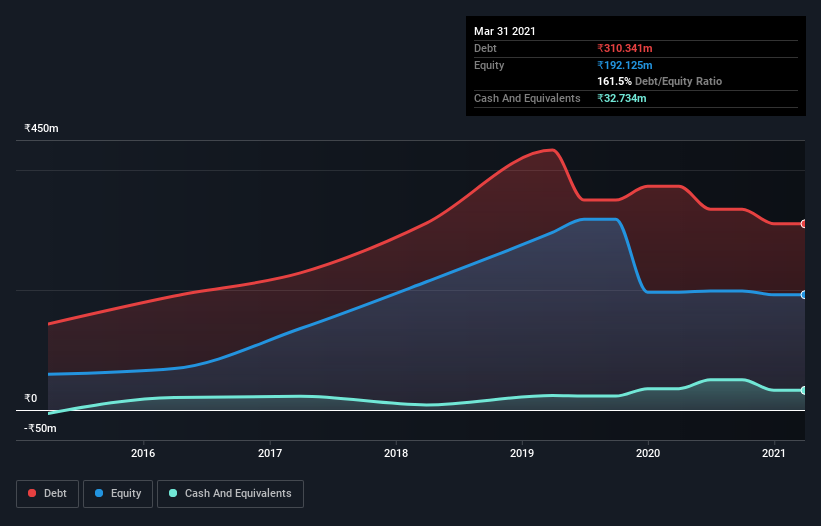Is Jet Freight Logistics (NSE:JETFREIGHT) A Risky Investment?

David Iben put it well when he said, 'Volatility is not a risk we care about. What we care about is avoiding the permanent loss of capital.' When we think about how risky a company is, we always like to look at its use of debt, since debt overload can lead to ruin. Importantly, Jet Freight Logistics Limited (NSE:JETFREIGHT) does carry debt. But the more important question is: how much risk is that debt creating?
When Is Debt Dangerous?
Debt is a tool to help businesses grow, but if a business is incapable of paying off its lenders, then it exists at their mercy. Part and parcel of capitalism is the process of 'creative destruction' where failed businesses are mercilessly liquidated by their bankers. While that is not too common, we often do see indebted companies permanently diluting shareholders because lenders force them to raise capital at a distressed price. Of course, the upside of debt is that it often represents cheap capital, especially when it replaces dilution in a company with the ability to reinvest at high rates of return. The first step when considering a company's debt levels is to consider its cash and debt together.
View our latest analysis for Jet Freight Logistics
How Much Debt Does Jet Freight Logistics Carry?
You can click the graphic below for the historical numbers, but it shows that Jet Freight Logistics had ₹310.3m of debt in March 2021, down from ₹372.9m, one year before. However, it also had ₹32.7m in cash, and so its net debt is ₹277.6m.

How Strong Is Jet Freight Logistics' Balance Sheet?
The latest balance sheet data shows that Jet Freight Logistics had liabilities of ₹634.6m due within a year, and liabilities of ₹128.5m falling due after that. Offsetting this, it had ₹32.7m in cash and ₹576.9m in receivables that were due within 12 months. So its liabilities total ₹153.5m more than the combination of its cash and short-term receivables.
Jet Freight Logistics has a market capitalization of ₹380.5m, so it could very likely raise cash to ameliorate its balance sheet, if the need arose. But we definitely want to keep our eyes open to indications that its debt is bringing too much risk.
We measure a company's debt load relative to its earnings power by looking at its net debt divided by its earnings before interest, tax, depreciation, and amortization (EBITDA) and by calculating how easily its earnings before interest and tax (EBIT) cover its interest expense (interest cover). Thus we consider debt relative to earnings both with and without depreciation and amortization expenses.
While Jet Freight Logistics's debt to EBITDA ratio (3.6) suggests that it uses some debt, its interest cover is very weak, at 1.9, suggesting high leverage. So shareholders should probably be aware that interest expenses appear to have really impacted the business lately. However, the silver lining was that Jet Freight Logistics achieved a positive EBIT of ₹63m in the last twelve months, an improvement on the prior year's loss. There's no doubt that we learn most about debt from the balance sheet. But it is Jet Freight Logistics's earnings that will influence how the balance sheet holds up in the future. So if you're keen to discover more about its earnings, it might be worth checking out this graph of its long term earnings trend.
Finally, while the tax-man may adore accounting profits, lenders only accept cold hard cash. So it is important to check how much of its earnings before interest and tax (EBIT) converts to actual free cash flow. Over the last year, Jet Freight Logistics actually produced more free cash flow than EBIT. That sort of strong cash generation warms our hearts like a puppy in a bumblebee suit.
Our View
When it comes to the balance sheet, the standout positive for Jet Freight Logistics was the fact that it seems able to convert EBIT to free cash flow confidently. However, our other observations weren't so heartening. In particular, interest cover gives us cold feet. Looking at all this data makes us feel a little cautious about Jet Freight Logistics's debt levels. While debt does have its upside in higher potential returns, we think shareholders should definitely consider how debt levels might make the stock more risky. The balance sheet is clearly the area to focus on when you are analysing debt. However, not all investment risk resides within the balance sheet - far from it. To that end, you should learn about the 3 warning signs we've spotted with Jet Freight Logistics (including 2 which are significant) .
If, after all that, you're more interested in a fast growing company with a rock-solid balance sheet, then check out our list of net cash growth stocks without delay.
If you decide to trade Jet Freight Logistics, use the lowest-cost* platform that is rated #1 Overall by Barron’s, Interactive Brokers. Trade stocks, options, futures, forex, bonds and funds on 135 markets, all from a single integrated account. Promoted
New: Manage All Your Stock Portfolios in One Place
We've created the ultimate portfolio companion for stock investors, and it's free.
• Connect an unlimited number of Portfolios and see your total in one currency
• Be alerted to new Warning Signs or Risks via email or mobile
• Track the Fair Value of your stocks
This article by Simply Wall St is general in nature. It does not constitute a recommendation to buy or sell any stock, and does not take account of your objectives, or your financial situation. We aim to bring you long-term focused analysis driven by fundamental data. Note that our analysis may not factor in the latest price-sensitive company announcements or qualitative material. Simply Wall St has no position in any stocks mentioned.
*Interactive Brokers Rated Lowest Cost Broker by StockBrokers.com Annual Online Review 2020
Have feedback on this article? Concerned about the content? Get in touch with us directly. Alternatively, email editorial-team (at) simplywallst.com.
About NSEI:JETFREIGHT
Jet Freight Logistics
Engages in the freight forwarding business in India.
Good value with acceptable track record.
Market Insights
Community Narratives



